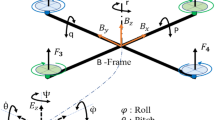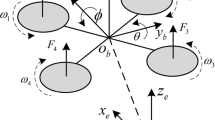Abstract
Quad-rotor unmanned aerial vehicle (UAV) is a typical multiple-input-multiple-output underactuated system with couplings and nonlinearity. Usually, the flying environment is very complex, so that it is impossible for the UAV to avoid effects derived from disturbances and uncertainties. In order to improve the reliability of flight control, we established the dynamic model of quad-rotor UAV by Newton-Euler equation in unbalanced load conditions. Considering external disturbances in the attitude, a second-order sliding mode controller was designed with PID sliding mode surface and Extended State Observer (ESO). The simulation experiments have got good control performance, illustrating the effectiveness of our controller. Meanwhile, the controller was implemented in a quad-rotor UAV, which carried a pan-tilt camera for aerial photography. The actual flight experiments proved that this paper dealt with the high stabilization flight control problem for the quad-rotor UAV, which laid a good foundation for autonomous flight of the UAV.
Similar content being viewed by others
References
Zhou HL, Kong H, Wei L, et al., Efficient road detection and tracking for unmanned aerial vehicle, IEEE Transactions on Intelligent Transportation Systems, 2015, 16(1): 297–309.
Nedjati A, Vizvari B, and Izbirak G, Post-earthquake response by small UAV helicopters, Natural Hazards, 2016, 80(3): 1669–1688.
Giannetti F, Chirici G, Gobakken T, et al., A new approach with DTM-independent metrics for forest growing stock prediction using UAV photogrammetric data, Remote Sensing of Environment, 2018, 195–205.
Hodgson A, Kelly N, and Peel D, Unmanned aerial vehicles (UAVs) for surveying marine fauna, A Dugong Case Study, Plos One, 2013, 8(11): e79556.
Zhu J C, Liu E D, Guo S, et al., A Gradient Optimization based PID Tuning Approach on Quadrotor, Proceeding of the 27th Chinese Control and Decision Conference (CCDC), Qingdao, China, 2015, 1588–1593.
Bouabdallah S, Noth A, and Siegwart R, PID vs LQ control techniques applied to an indoor micro quadrotor, Proceedings of IEEE/RSJ International Conference on Intelligent Robots and Systems Sendai, Japan, 2004, 3: 2451–2456.
Chen F Y, Lei W, Zhang K K, et al., A novel nonlinear resilient control for a quadrotor UAV via backstepping control and nonlinear disturbance observer, Nonlinear Dynamics, 2016, 85(2): 1281–1295.
Palunko I and Fierro R, Adaptive control of a quadrotor with dynamic changes in the center of gravity, Proceedings of the 18th IFAC World Congress, Milan, 2011, 2626–2631.
Li S S, Wang Y N, and Tan J H, Adaptive and robust control of quadrotor aircrafts with input saturation, Nonlinear Dynamics, 2017, 89(1): 255–265.
Tian B L, Cui J, Lu H C, et al., Adaptive finite-time attitude tracking of quadrotors with experiments and comparisons, IEEE Transactions on Industrial Electronics, 2019, 66(12): 9428–9438.
Dierks T and Jagannathan S, Output feedback control of a quadrotor UAV using neural networks, IEEE Transactions on Neural Networks, 2010, 21(1): 50–66.
Liu H, Li D J, Zuo Z Y, et al., Robust attitude control for quadrotors with input time delays, Control Engineering Practice, 2017, 58: 142–149.
Zou Y, Nonlinear robust adaptive hierarchical sliding mode control approach for quadrotors, International Journal of Robust and Nonlinear Control, 2017, 27(6): 925–941.
Nafia N, El Kari A, Ayad H, et al., Robust full tracking control design of disturbed quadrotor uavs with unknown dynamics, Aerospace, 2018, 5(4): 115.
Nicotra M M, Garone E, Naldi R, et al., Nested saturation control of a UAV carrying a suspended load, American Control Conference, Portland, Oregon, USA, 2014, 3585–3590.
Pizetta I H B, Brandao A S, and Sarcinelli-Filho M, Cooperative quadrotors carrying a suspended load, International Conference on Unmanned Aircraft Systems, Arlington, VA, USA, 2016, 1049–1055.
Cruz P J, Oishi M, and Fierro R, Lift of a cable-suspended load by a quadrotor: A hybrid system approach, American Control Conference, Chicago, IL, USA, 2015, 1887–1892.
Guerrero M E, Mercado D A, Lozano R, et al., Passivity based control for a quadrotor UAV transporting a cable-suspended payload with minimum swing, IEEE Conference on Decision and Control, Osaka, Japan, 2015, 6718–6723.
Alothman Y, Jasim W, and Gu D, Quad-rotor lifting-transporting cable-suspended payloads control, International Conference on Automation and Computing, Glasgow, UK, 2015, 1–6.
Lee T, Geometric control of multiple quadrotor UAVs transporting a cable-suspended rigid body, IEEE Conference on Decision and Control, Los Angeles, CA, USA, 2014, 6155–6160.
Wu G and Sreenath K, Geometric control of multiple quadrotors transporting a rigid-body load, IEEE Conference on Decision and Control, Los Angeles, CA, USA, 2014, 6141–6148.
Lee T, Sreenath K, and Kumar V, Geometric control of cooperating multiple quadrotor UAVs with a suspended payload, IEEE Conference on Decision and Control, Florence, Italy, 2013, 5510–5515.
Maza I, Ollero A, Casado E, et al., Classification of multi-UAV architectures, Handbook of Unmanned Aerial Vehicles, 2014, 953–975.
Sayyaadi H and Soltani A, Modeling and control for cooperative transport of a slung fluid container using quadrotors, Chinese Journal of Aeronautics, 2018, 31(2): 62–72.
Zhang D Y, Wu Q H, and Yao X L, Bandwidth based stability analysis of active disturbance rejection control for nonlinear uncertain systems, Journal of Systems Science and Complexity, 2018, 31(6): 1449–1468.
Guo Y J, Yu L, and Xu J M, Robust finite-time trajectory tracking control of wheeled mobile robots with parametric uncertainties and disturbances, Journal of Systems Science and Complexity, 2019, 32(5): 1358–1374.
Runcharoon K and Srichatrapimuk V, Sliding mode control of quadrotor, Proc., IEEE Int. Conf. on Technological Advances in Electrical, Electronics and Computer Engineering, New York, 2013, 552–557.
Chen Q, Tao L, and Nan Y R, Full-order sliding mode control for high-order nonlinear system based on extended state observer, Journal of Systems Science and Complexity, 2016, 29(4): 978–990.
Author information
Authors and Affiliations
Corresponding author
Additional information
This research was supported by the National Natural Science Foundation of China under Grant No. 61503151.
This paper was recommended for publication by Editor SUN Jian.
Rights and permissions
About this article
Cite this article
Kang, B., Miao, Y., Liu, F. et al. A Second-Order Sliding Mode Controller of Quad-Rotor UAV Based on PID Sliding Mode Surface with Unbalanced Load. J Syst Sci Complex 34, 520–536 (2021). https://doi.org/10.1007/s11424-020-9306-6
Received:
Revised:
Published:
Issue Date:
DOI: https://doi.org/10.1007/s11424-020-9306-6




